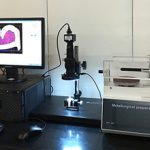Email:
zhaizhongbing723@gmail.com
With the continuous development of biotechnological sciences, the demand for chromosome karyotype analysis is increasingly growing. Chromosome karyotype analysis has a wide range of applications in genetics, biology, medicine, and other fields. It is an important means of studying the transmission of genetic information in organisms, gene expression regulation, and disease diagnosis. Traditional chromosome karyotype analysis mainly relies on professional personnel to observe the morphology of chromosomes through a microscope, which is not only time-consuming but also susceptible to human factors. To improve the efficiency and accuracy of chromosome karyotype analysis, the development of a microscope chromosome karyotype analysis upper computer software is of great significance.
The development of microscope chromosome karyotype analysis upper computer software mainly includes the following aspects:
The image acquisition module is a key part of the software, mainly responsible for obtaining chromosome images from microscope equipment. High-quality image acquisition provides a good foundation for subsequent image processing and analysis. To achieve this, we need to choose high-performance digital cameras or scanners and equip them with appropriate lighting equipment. In addition, the stability of the light source’s impact on image quality must be considered, so temperature and brightness control of the light source is necessary.
The image processing module is mainly responsible for preprocessing the collected chromosome images, including denoising, smoothing, edge detection, and other operations. Denoising is to eliminate random noise in the image to improve image clarity; smoothing can eliminate minor fluctuations in the image, making the chromosome lines smoother; edge detection is to accurately extract the edge information of chromosomes for subsequent analysis.
The chromosome segmentation module is responsible for segmenting the processed images into individual chromosomes. This step is achieved by introducing morphological operations, region growing algorithms, and other methods. In addition, some thresholds and parameters need to be set based on professional knowledge and experience to better recognize chromosomes. The segmented chromosomes can be stored in a database for subsequent analysis.
The chromosome analysis module is based on the segmented chromosome images for karyotype analysis. This module can automatically recognize information such as the arms, centromeres, and chromosome numbers of chromosomes, and calculate parameters such as the length and area of chromosomes. In addition, it can compare the results with human eye recognition to evaluate the accuracy of the analysis.
The result output module is responsible for displaying the analysis results to the user in a visual way. Through this module, users can intuitively view the analysis results, including the morphology, quantity, and order of chromosomes. In addition, the analysis results can be exported in common image formats for further processing and analysis.
The user interface module is the bridge between people and the software. It needs to provide an intuitive and easy-to-operate interface, allowing users to easily complete chromosome karyotype analysis. The interface should include the following functions: image import, processing parameter settings, analysis result viewing, and export, etc.
In summary:
The development of microscope chromosome karyotype analysis upper computer software has important practical significance. By introducing advanced image processing technology and artificial intelligence algorithms, the efficiency and accuracy of chromosome karyotype analysis can be improved, providing strong support for research in biology, medicine, and other fields. At the same time, the software can also be further optimized and expanded to meet the needs of different scenarios. In the future, we have reason to believe that such upper computer software will play an increasingly important role in the field of chromosome karyotype analysis.

Microscope Chromosome Karyotype Analysis Upper Computer Software Development
With the continuous development of biotechnological sci […]

Development of host computer program for electric servo test
The application of electric actuators in various fields […]

Development of an Intelligent Picking System for Robotic Arms Based on Machine Vision
Intelligent manufacturing is gradually becoming an impo […]

Custom Development of an Online Monitoring System for Production Equipment
The manufacturing sector plays an increasingly vital ro […]

Development of a Frequency Converter Upper Computer System
Frequency converters, as pivotal equipment for regulati […]

Custom Development of Ultrasonic Radar Testing Upper Computer
The demand for ultrasonic radars in fields such as auto […]

Software Development for Water Quality Algae Monitoring and Identification System.
Project BackgroundFaced with the professional detection […]

Smart Home Living Kitchen System: Dual-End Cooking Robot APP Development
Project Background To enhance the core competitiveness […]

Smart Weeding Machine Android and iOS Mobile Dual-Platform Control APP Program Development and Customization
Case Background With the advancement of technology and […]

Development of an Automated Control Host Computer System for Laboratory Microscopes
Project Background A certain biotechnology company spec […]

The development of an intelligent self-service charging station control system for new energy electric vehicles
Project Background With the development of smart grids, […]

Cross-border e-commerce shop agent declaration platform system: Oudai independent declaration software customization development
Case Background According to the new regulations on com […]


WhatsApp:
Email:zhaizhongbing723@gmail.com
Address:Zone E, 10th Floor, HongKong Shenzhen International Center, Longhua District, Shenzhen